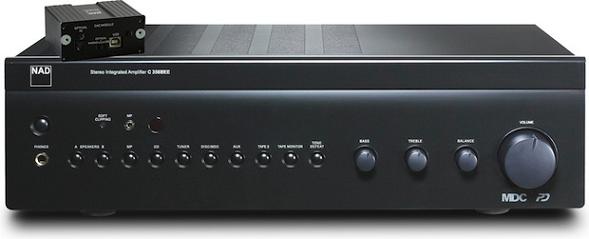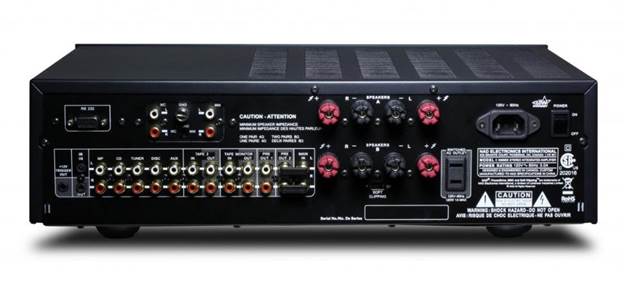The unique modular design concept of this integrated ensures
that this is an amplifier for all seasons
Perhaps more than any other brand in this test, NAD is all
about affordable integrated amplifiers that deliver top-notch performance for
sensible outlay, dating all the way back to the 3020. While the company has
been exploring some of the more exciting ends of the price spectrum with some
recent designs, it hasn’t forgotten its roots and the C 356BEE DAC is a lot of
amp for the money.

NAD C 356BEE DAC
The versatile design with eight line-level inputs is
available as a standard amp for $959.58, but this one comes fitted with a
digital input board as part of NAD’s Modular Design Concept (MDC). Testing the
digital inputs falls outside the strict remit of the review, but a quick trial
run of the asynchronous USB input suggests that this is the best performing
digital input of any in the test and makes the amp a bit of a bargain for
anyone with a computer as a source. A phonon stage is also available, although
NAD isn’t heartless enough to make you choose between the two as you can still
use one of its external phonon stages as well as the digital module.
The NAD is not the most beautiful amp, finished in the
customary field grey, but it does feel well assembled and well thought out. The
controls are logical and easy to use with small LEDs to show source and speaker
selection and aside from the slightly fiddly tone controls, it is pleasant
enough to interact with. The remote is a little fussy, but does feature
backlighting that’s handy for anyone who does their listening in low light.
Sound quality
The NAD shows some distinctive traits from the off with the
test material and most of them are likeable. Even after very careful level
matching on all six amps, the C 356BEE DAC sounds bigger than the other
offerings. The vocals in the Muse recording and the piano in the Neil Cowley
piece take on a slightly larger than life quality and the soundstage seems to
extend a little further outside the speaker than the other amps. This means
that some of the delicacy of the Neil Cowley piece is lost and some of the
higher notes have a fractional harshness, but this is comparatively minor.
With the more aggressive and up-tempo parts of the test
material, the news is still largely positive. The NAD has a usefully civilizing
influence on the Scratch Massive track, but doesn’t over smooth it or lose the
drive and attack that it needs to remain convincing.

The NAD shows some
distinctive traits from the off with the test material and most of them are
likeable
Similarly Aloe Blacc’s vocals are given the same slightly
larger than life treatment, but this time the results are more satisfying. The
area that holds the NAD back with the faster pieces is the bass, which is deep
and powerful, but does find itself lacking some of the fine detail that the
best in test can manage with the same material. There is plenty of impact, but
the impression is slightly monotone rather than that of multiple notes. If you
have a slightly lean-sounding system though, the weight of the NAD is likely to
be helpful in alleviating this.
The C 356BEE DAC is an impressive proposition for the asking
price – especially if you can make use of that USB input and there is a lot to
like about the powerful and lively sound that it produces. The slightly
oversized presentation and somewhat exuberant bass has to be taken into account
and needs careful partnering to get the best out of it.

The NAD is not the
most beautiful amp, finished in the customary field grey, but it does feel well
assembled and well thought out
One test
If there’s one thing you can almost guarantee from any NAD
amplifier then that is oodles of dynamic power. So while the C 356BEE already
betters its 2x80W specification at 2x115W/8ohm, under dynamic, music-like
conditions it’ll deliver a whopping 190W, 335W and 540W (16.4A) into 8, 4 and
2ohm loads. This is why NAD’s C 356BEE sounds louder than its contemporaries
here even if its maximum current rating is still less than Rotel’s
astonishingly load-tolerant RA-12.
Distortion increases with power (0.0003% to 0.01% over an
80W range), and particularly with decreasing load (0.005% at 60W/8ohm to 0.03%
at 60W/4ohm), but the nature of the distortion itself is relatively benign.
Finally, the A-wtd S/N ratio is very wide at 95.6dB and the response powerfully
extended into the high treble (–1dB/100kHz) so there’s no attenuation of
ultrasonic noise from SACD, for example.
Our verdict
·
Sound quality: 4.5/5
·
Value for money: 4.5/5
·
Build quality: 4/5
·
Features: 4.5/5
·
Like: Big, confident sound; excellent USB input and useful power
·
Dislike: Can sound a little unruly at the bottom and can be a
little harsh
·
We say: A strong value amp that needs careful matching to get the
best results
·
Overall: 4.5/5
|
Details
·
Product: NAD C 356BEE DAC
·
Origin: Canada/China
·
Type: Integrated amplifier
·
Weight: 9.5kg
·
Dimensions (W x H x D): 435 x 130 x 337mm
·
Features: Quoted power output: 80W RMS per channel into 8ohms;
Available finishes: black/silver; Line inputs: 8 RCA inputs; Digital inputs:
USB/optical
·
Distributor: Seven oaks Sound and Vision
|